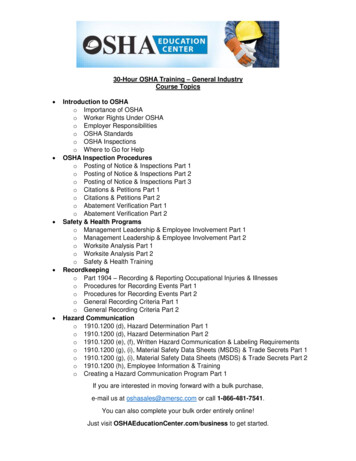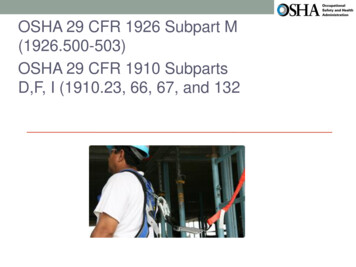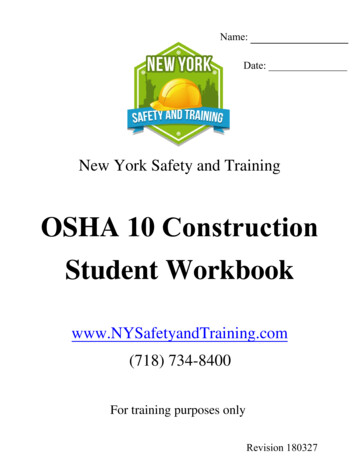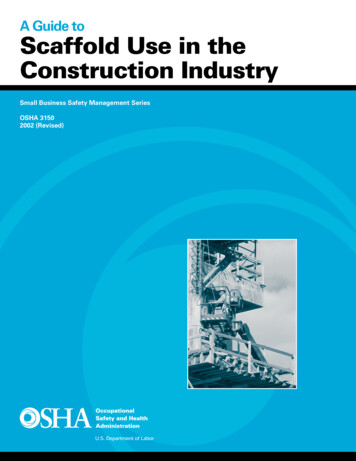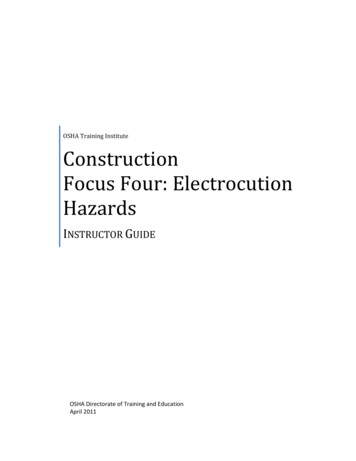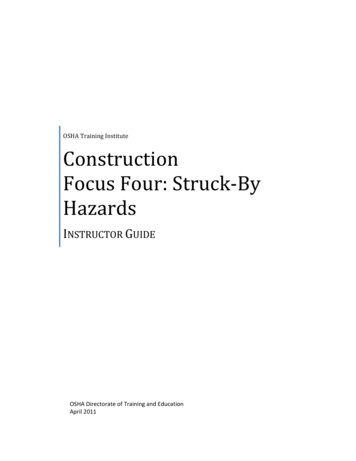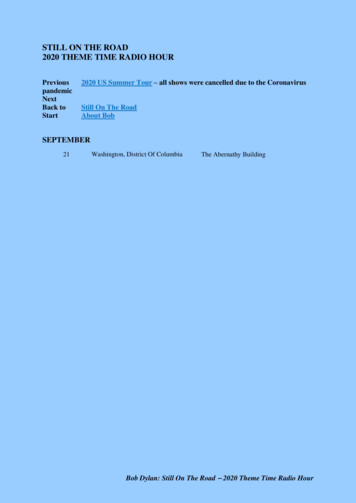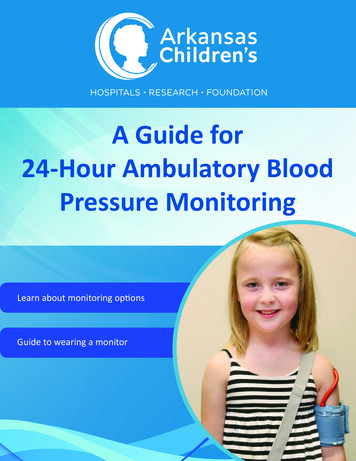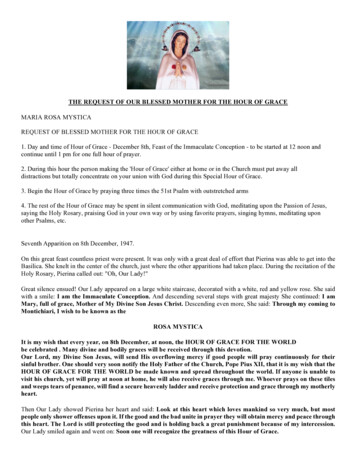
Transcription
TeamstersConstruction IndustrySafety & Health Training10-Hour OSHA ConstructionSafety & Health Outreach CourseElectronic Version is Section 508 CompliantInternational Brotherhood of Teamsters — IBT Worker Training Program
Teamsters10-Hour OSHA Construction Safety & Health Outreach CourseElectronic version is 508 Compliant2018 EditionThe project described was supported by Award Number U45ES014084 andU45ES014103 from the National Institute Of Environmental Health Sciences.The content is solely the responsibility of the authors and does not necessarilyrepresent the official views of the National Institute Of Environmental HealthSciences or the National Institutes of Health. Copyright 2018International Brotherhood of TeamstersSafety & Health Department25 Louisiana Ave. N.W.Washington, D.C. 20001(202) 624-6963ibt niehsgrant@teamster.orgwww.teamster.org
Table of ContentsModule 1:Module 2:Module 3:Module 4:Module 5:Module 6:Module 7:Module 8:Module 9:Module 10:Module 11:Module 12:Module 13:Module 14:Module 15:Module 16:Introduction to OSHA. 8Fall Protection. 22Electrical Safety. 38Struck-By and Caught-In Hazards. 52Personal Protective Equipment. 60Health Hazards and HAZCOM. 74Stairways and Ladders. 92Materials Handling, Storage, and Disposal. 102Tools - Hand and Power. 116Scaffolds. 128Cranes, Derricks, Hoists, Elevators and Conveyors. 148Excavations. 164Heat, Noise & Ergonomic Hazards. 180Fire Prevention Plans and Fire Protection. 192Confined Spaces. 206Motor Vehicles. 216- Page 3 -
PrefaceThis manual covers the topics that OSHA prescribes for10-hour courses under the OSHA Construction IndustryOutreach Safety and Health Training Program. This coursemay only be taught by authorized instructors who havesuccessfully completed the OSHA Construction IndustryTrainer Course, OSHA 500.This manual was prepared by the Worker Training Programof the International Brotherhood of Teamsters - theTeamsters Union - with funds from the National Institute ofEnvironmental Health Sciences.OSHA OutreachTraining ProgramGuidelinesThe requirements of the OSHA Outreach Training Programfor the Construction Industry are outlined on the followingpage. You may download a complete copy of OSHA’sGuidelines for this program at www.osha.gov (Click on“Training”).CourseRequirementsThis is a basic, introductory safety and health course, andthere is no prerequisite for taking it. There is also no requiredrefresher for this course, although employers and employeesmight benefit if workers took this course again from time totime.This course may be taught over a period of time, no longerthan six months, with each session lasting at least one hour.Although OSHA prescribes the topics that must be includedin this course, the specific content of each topic should bechosen to best meet the needs of the workers involved,taking into account their job tasks, and the hazards that theyencounter.OSHA subpart references are provided for informationalpurposes; training should emphasize hazard awareness.- Page 4 -
The International Brotherhood of Teamsters, with 1.4 millionmembers, is one of the largest labor unions in the world.It is also the most diverse union in the United States. TheTeamsters represent all types of workers - from airline pilotsto zookeepers. One out of every ten union members is aTeamster.There are hundreds of Teamsters Local Unions across NorthAmerica. The local unions and their members are the heartand backbone of the union.Unlike other labor unions, the Teamsters Union is structuredto promote strong local unions, and strong local leaders.Since the locals negotiate most Teamsters contracts andprovide most of the services to the members, they keepmost of the dues money. Locals retain their own expert laborlawyers, certified public accountants, full-time businessagents, organizers, and clerical staff.The Members of each local elect their own officers,devise their own structure, and vote on their own bylaws,compatible with the International Constitution and Bylaws.While enjoying their independence, the locals benefit fromthe expertise and assistance of the International Union,and of the various conferences and councils in the union’sstructure.Teamsters Joint Councils are set up in areas with three ormore local unions. Joint Councils help coordinate Teamstersactivities in those areas. They also help solve problems anddecide some jurisdictional and judicial matters.Teamster Trade Divisions and Conferences aid Teamsterleaders throughout the country who share common interestsand problems. They provide an informational clearinghousefor locals that negotiate in the same industry or bargain withthe same employer.- Page 5 -About theTeamsters
Teamster Safetyand HealthDepartmentThe Teamsters were one of the first unions to establisha Safety and Health Department. The Safety and HealthDepartment is committed to protecting the health andwell-being of Teamster members, their families and theircommunities from chemical, biological, and physical healthand safety hazards.The IBT Safety and Health Department includes professionalsin safety, industrial hygiene and adult education.The Safety and Health Department provides manyeducational resources on line. Visit www.teamster.org andclick on “Members”, and then “Safety & Health.”Teamster TrainingThe Teamsters offer safety and health training throughoutthe United States for: Construction Workers Hazardous Waste Workers Industrial Workers Hazardous Materials Transportation Workers Port Workers Emergency Responders Radiological Workers- Page 6 -
Teamster instructors use effective adult education, realequipment, and realistic hands-on activities.Teamster TrainingCentersTeamster instructors have experience doing the sametypes of jobs that trainees perform, including hazmattransportation, warehousing, construction and remediation.Instructors use participatory adult teaching techniquesand hands-on activities. Instructors have completed theOSHA 500 and 501 Construction and General IndustryTrainer Courses. Teamster instructors complete a period ofsupervised teaching and evaluation. Each instructor attendsan annual Instructor Development Program that includesnew regulations and work procedures, and practice teaching.Each Instructor is certified in first aid / CPR.Teamster Training Centers have classrooms and outdoorareas for realistic hands-on activities. The Training Centersalso have mobile units that can transport instructors andequipment to hold courses at hazardous waste sites,construction projects, company locations and union halls .anywhere.For more information, or to schedule a course, contact:IBT Worker Training Program25 Louisiana Avenue, N.W.Washington, DC 20001(202) 624-6963(202) 624-8125 (fax)www.teamster.org- Page 7 -TeamsterInstructorsFor MoreInformation
ModuleOSHA1Introduction to OSHALearning objectivesThis module introduces the OSHA standards that apply to construction work, andthe rights and responsibilities of workers and employers with regard to occupationalsafety and health.After completing this module you will be able to demonstrate your ability to:1. DESCRIBE briefly the history and purpose of OSHA and the OSH Act.2. IDENTIFY the safety and health rights and responsibilities of employers andemployees.3. IDENTIFY the rights of whistle-blowers.4. DESCRIBE what to do if you feel that it is unsafe to do an assigned task.5. IDENTIFY the basic OSHA record keeping requirements.6. IDENTIFY the qualifications of a competent person.7. EXPLAIN the General Duty Clause.8. RECOGNIZE that there are resources available from OSHA through its web site and800 number.- Page 8 -
OSHA stands for the Occupational Safety and HealthAdministration. It is the federal agency that enforces safetyand health standards to protect workers.OSHA and theOSH ActIn 26 states there are state safety and health agencies thatdo this job instead of federal OSHA.States that have their ownOccupational Safety and Health chiganMinnesotaNevadaNew Jersey*New MexicoSouth CarolinaTennesseeUtahVermontVirgin Islands*IndianaIowaKentuckyMarylandNew York*North CarolinaOregonPuerto RicoVirginiaWashingtonWyoming* The programs in CT, NJ, NY and VI only apply to public employees.In 1970 Congress passed a law called the OccupationalSafety and Health Act, or OSH Act. This law created OSHA,and gave OSHA the power to write safety and healthstandards.In addition to creating OSHA, the OSH Act also createdNIOSH, the National Institute for Occupational Safetyand Health. This federal agency studies safety and healthproblems, recommends standards, and gives advice toworkers and employers.- Page 9 -NIOSH
Purpose of theOSH ActThe OSH Act says:Responsibilitiesof EmployersSection 5 of the OSH Act declares the responsibilities ofemployers with regard to safety and health:The Congress declares its purpose and policy.to assureso far as possible every working man and woman in theNation safe and healthful working conditions and topreserve our human resources.Each employer (1) shall furnish to each of its employees employment anda place of employment which are free from recognizedhazards that are causing or are likely to cause death orserious physical harm to its employees;(2) shall comply with the occupational safety and healthstandards promulgated under this Act.Your employer has two responsibilities: (1) to provide youwith safe and healthy work and a safe and healthy workplace, and (2) to comply with OSHA standards.General DutyClauseThe first of these employer responsibilities is called theGeneral Duty Clause. The General Duty Clause means thateven if there is no OSHA Standard about a particular safetyor health problem, the employer still has to make surethat your workplace is safe, healthy and free of recognizedhazards.- Page 10 -
Section 5 of the OSH Act also describes the duty ofemployees:Responsibilitiesof EmployeesEach employee shall comply with occupational safety andhealth standards and all rules, regulations, and ordersissued pursuant to this Act which are applicable to his ownactions and conduct.OSHA does not issue orders to workers. It does not fineworkers. As an employee you are expected to complywith the instructions issued by your employer. Theseinclude following safe work practices and wearing personalprotective equipment required by OSHA. If you fail to followyour supervisor’s instructions you might be disciplined orterminated.OSHA writes rules, called OSHA Standards, to protectworkers on the job. There are many OSHA standards thatmay apply to your job. For example: standards which limitthe concentration of toxic substances in workplace air,standards for the safe operation of forklifts, or standards forelectrical safety.OSHA MakesRulesOSHA standards have the force of law.OSHA inspects work sites. OSHA can issue correction ordersand assess penalties against the employer. You have the rightto talk to the OSHA inspector, to point out hazards, and tosee a copy of the inspection report.- Page 11 -OSHA EnforcesRules
Your OSHA RightsOSHA requires your employer to: Provide a safe and healthy workplace. Comply with OSHA standards.As an employee, you have legal rights, and you also have theresponsibility to work in a safe manner in compliance withOSHA standards.Your OSHA rights include:1. The right to a safe and healthy workplace.2. The right to receive safety and health training.A. Hazard communication training.B. HAZWOPER emergency response training.C. Respirator training (if applicable).D. Confined space training (if applicable).3. The right to information.A. Material Safety Data Sheets (MSDSs).B. Your employer’s Log of Work-Related Injuries andIllnesses (the OSHA 300 Log).C. Results of workplace monitoring and surveys.D. Your own medical records.E. Your employer’s written safety and health plans.F. Copies of any OSHA citations.4. The right to take part in safety and health activities.A. Point out hazards and suggest corrections.B. Discuss safety and health concerns with your fellowworkers and your union representative.- Page 12 -
5. The right to participate in OSHA inspections.A. You or your union representative participate in theopening and closing conferences.B. You or your union representative accompany the OSHAinspector during the inspection.C. Respond to questions from the OSHA inspector.6. The right to file an OSHA complaint if a hazard exists.A. Have your name kept confidential by OSHA.B. Be told by OSHA of actions on your complaint.C. Be notified if your employer contests a citation.D. Object to an abatement period proposed by OSHA.7. The right to refuse to do work that would expose you toimminent danger of death or serious injury.(See the next page for more detail about this right.)8. Protection from retaliation or discrimination because ofyour safety and health activities.File a discrimination complaint with OSHA if you havebeen discriminated against for discussing safety andhealth, pointing out hazards, filing an OSHA complaint, orrefusing dangerous work.If you file a complaint with OSHA, put it in writing, bespecific, and cite the exact standard that’s being violated.Keep a copy for your records. Be sure to also contact yourunion representative.- Page 13 -Your OSHA Rights
Whistle-blowerRightsYou have the right to fil
This module introduces the OSHA standards that apply to construction work, and the rights and responsibilities of workers and employers with regard to occupational safety and health. After completing this module you will be able to demonstrate your ability to: 1. DESCRIBE briefly the history and purpose of OSHA and the OSH Act. 2. IDENTIFY the safety and health rights and responsibilities of employers
